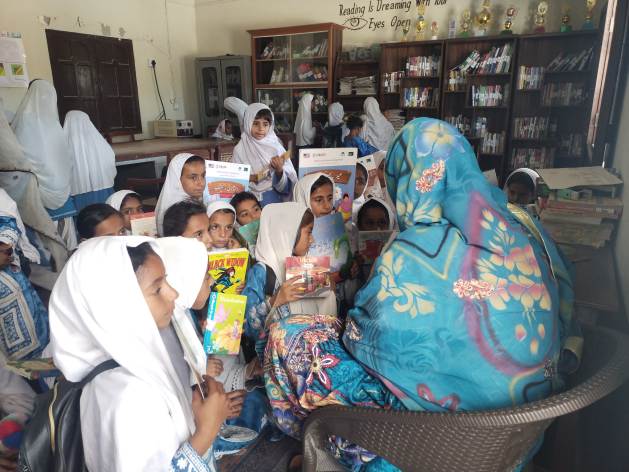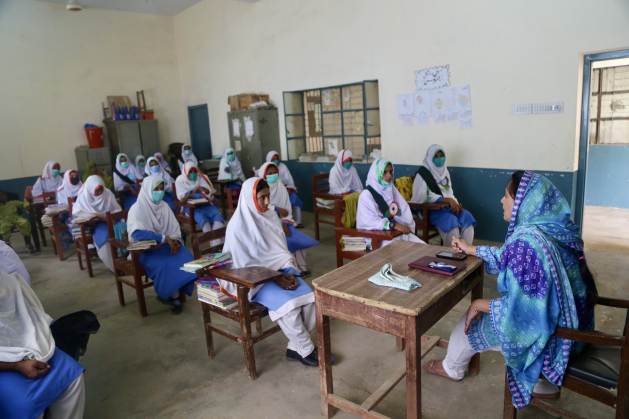GWADAR, Pakistan, Sep 13 (IPS) – Ten years ago I ran an academy for girls in Dohr Gatti, a small slum on the outskirts of Gwadar, a coastal city in Balochistan, southwestern Pakistan. Most of the girls were between the ages of eleven and fifteen and had the little opportunity to receive a formal education.
Plagued by tradition and poverty, their desire to learn was often thwarted by the tradition of marrying as soon as they reached puberty and spend the rest of their lives raising children, as their mothers had.
At the academy I tried to raise awareness in the community about how crucial it was for girls to receive an education. That worked, at least a little.
Years later, some girls in Dohr Gatti managed to enroll in local public schools. In 2021, one of my students got the highest score on the district’s annual eighth-grade exam.
But even that couldn’t change her destiny. Soon after her triumph on the test, which showed her potential to continue studying, she had to stop. She was married off and sent to a remote village, where she still lives with her in-laws and a husband much older than her.
I often wonder how far students like her could have gone if their right to education was protected and if they only had one chance to pursue their dreams.
The question often raised in such cases is “who exactly is to blame?”
Religion and tradition intermingle in Balochistan, a region of Pakistan which has its own language and culture but where, as in the rest of the country, Sunni Islam is hegemonic.
Parents, tradition, patriarchy, poverty, political unrest in the region, the education system itself, the government, all come under scrutiny. But the state of access to education for girls remains largely unchanged.

A luxury good
Balochistan is Pakistan’s largest yet most underdeveloped province. According to a World Bank report, the overall literacy rate in the province is 41 percent. It’s half that for women, 19 percent.
It’s no surprise that only two out of ten women can read in Balochistan, when UN data suggests that 78 percent of Baloch girls of school age do not go to school. For those who do manage to attend, the dropout rate among female students is much higher.
Despite these stark obstacles, some have made progress. Some Baloch women have not only completed their education and begun successful careers, but have also actively contributed to improving girls’ education in the region.
Anila Yousuf is the principal of a girls’ school in Pishukan, a small fishing village in southern Balochistan. She has recently been selected for Postgraduate studies in the United Kingdom, and recently published a collection of stories of women from Gwadar, her hometown.
But she’s aware she’s the exception:
“There´s lower enrollment among girls and many of them drop out of school as soon as they reach secondary school. This means that the number of women both in higher education and in the working sector is much lower,” Yousuf tells IPS.
Long-standing political tensions between Pakistan’s central government and Balochistan often takes some of the blame for the problem, with budgets for local education often treated as a political football.
However, a 2010 reform in Pakistan’s constitution transferred responsibility for education to local provinces, and led to increases in provincial public funding for education.
International agencies including the World Bank, UNICEF, US Partnership, and British Council have also been working through local organizations focused on reducing gendered disparities in provincial education.
Provincial ministers receive an annual ‘development fund’ to allocate towards various projects, including education initiatives, within their respective constituencies. Critics say the money does not appear to have chipped away at the problem much, however.
“There is no proper planning for effective use of funds. Not even public-school teachers enroll their children in them,” says Yousuf. “They choose private schools or send their children outside the province.”
Private schools have become a thriving business in the towns and cities of the province. But with 60% of the population living below the poverty line, private schooling for girls is a luxury inaccessible to the majority.
The lack of women with formal educations in Balochistan has affected the local labor market, and limited many Baloch women’s ability to start careers. According to Yousuf, most of the few women who enter the workforce are usually teachers or healthcare workers.
“I fear that we are going backwards throughout the country. Women are increasingly locked up at home. There are still specific markets for them and more and more Koranic schools are seen, more women hidden under a burla,” says the activist.
Gender roles
Zaitoon Kareen, a university professor in Uthal, Balochistan, tells IPS that educating a daughter is always more expensive in Balochistan.
“Baloch girls need assistance, especially for higher education when they have to travel and live in a different town or city. They need better shelters and someone to accompany them when traveling to schools or universities for safety reasons,” explains Kareen.
She will be leaving the province herself soon, after being accepted for a Postgraduate study in the UK.
The Annual Status of Education Report (ASER) suggests that girls only attend school if there is one close to home. But with only 26 percent of primary schools, 42 percent of lower secondary and 36 percent of upper secondary schools accepting girls, it’s often hard for families to find a neighborhood school their daughters can attend.
“When parents can only afford to invest in the education of a single child, they tend to prioritize the boy, as he is more likely to get a paid job and live with his parents in the future,” Hafsa Qadir, an activist with WANG -a local NGO- tells IPS.
In 2020, the Baloch provincial government attempted to address the problem, claiming a new educational plan, the Educational Sector Plan 2020-25, would address the disparity.
But COVID-19 and the devastating floods of 2022 wiped out hundreds of schools and roads in the region, the plans were derailed.
Zakia Baloch, a local woman who attended school and now works as a physical therapist — one of the first women to work in the field in the region — said part of the problem is the schools themselves often dissuade girls from continuing their education.
“Instead of providing proper education, there is often a heavy emphasis on traditional gender roles, preparing girls primarily for domestic roles rather than equipping them for careers and empowering them as independent individuals,” she says.
She called the government-funded education system “negligent” in its teacher selection process, resulting in “inadequately trained educators with very limited skills and exposure.”
“In 2023, when technology has opened many avenues of learning, our system is still locked in a cocoon,” laments the Baloch woman.
© Inter Press Service (2023) — All Rights ReservedOriginal source: Inter Press Service
Check out our Latest News and Follow us at Facebook
Original Source

